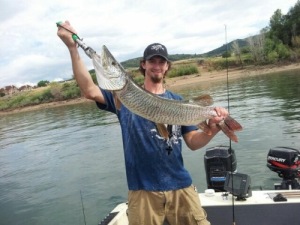Post
Utah DWR Uses Ideas from Anglers
Regional Fishing, United States Fishing Articles, Utah Fishing Articles | Utah theangler PM

Allow anglers to have up to three hooks on their fishing line.
Currently, Lake Powell and Flaming Gorge are the only waters in Utah at which anglers can use up to three hooks.
Drew Cushing, warm water sport fisheries coordinator for the Division of Wildlife Resources, thinks walleye, bass and fly anglers are among those who will be excited about the proposed change.
“Some of the more experienced fly anglers are using a rig that consists of a large fly with nymph ‘trailers’ attached to it,” Cushing says. “Allowing them to fish three trailers, instead of two, will give them a better chance to catch fish.”
Cushing says bass and walleye anglers are starting to use umbrella rigs. An umbrella rig consists of two or more lures that are attached together. As the rig is pulled through the water, it imitates a small school of fish swimming together.
“Just like with fly anglers,” Cushing says, “allowing bass and walleye anglers to use three hooks will give them a better chance to catch fish.”
Umbrella rigs often include more than three lures. If the change is approved, only three of the lures in a rig could have hooks on them. “If only three of the lures had hooks on them,” Cushing says, “the rig would still be very effective.”
Umbrella rigs and worm harnesses are currently sold in Utah, but they’re not legal to use in the state if they have more than two hooks. “This change would make it legal to use umbrella rigs and worm harnesses that have up to three hooks,” Cushing says.

Currently, bow fishing for common carp is allowed only during the day.
Cushing says anything that can legally be done to remove carp is a good thing. “Carp populations grow quick,” he says, “and they’ll eat anything, so they compete for food with all of the other fish in the water.”
Also, carp grow fast. They don’t stay small long enough to provide adequate forage for other fish. “And that isn’t all,” Cushing says. “Carp stir up the mud on the bottom of the waters they’re in. They also feed on and damage aquatic plants. The mud they stir up prevents sunlight from reaching the plants. The damaged plants can’t repair themselves, and new plants can’t grow.”
Cushing says 1,367 anglers responded to a survey that was available on the DWR’s website from mid May to mid June.
Because of how the survey was conducted (for example, it was offered online to anyone who wanted to take it), Cushing says the survey isn’t statistically valid, and it doesn’t represent every angler in Utah. But he’s still excited about the number of anglers who responded to the survey and the ideas they shared.
All of the fishing changes the DWR is recommending for 2013 are available at wildlife.utah.gov/public_meetings.
After you’ve reviewed the ideas, you can let your Regional Advisory Council members know your thoughts by attending your upcoming RAC meeting or by sending an email to them.
RAC chairmen will share the input they receive with members of the Utah Wildlife Board. The board will meet in Salt Lake City on Nov. 1 to approve fishing rules in Utah for 2013.
Dates, times and locations for the RAC meetings are as follows:
Central Region
Sept. 11, 6:30 p.m.
Springville Public Library Meeting Room
45 S Main Street, Springville
Northern Region
Sept. 12, 6 p.m.
Brigham City Community Center
24 N 300 W, Brigham City
Southern Region
Sept. 18, 7 p.m.
Richfield High School
510 W 100 S, Richfield
Southeastern Region
Sept. 19, 6:30 p.m.
Emery County Building
75 E Main ST, Castle Dale
Northeastern Region
Sept. 20, 6:30 p.m.
DWR Northeastern Region Office
318 N Vernal Ave, Vernal
You can also provide your comments to your RAC via email. Email addresses for your RAC members are available at wildlife.utah.gov/public_meetings.
The group each RAC member represents (sportsman, non-consumptive, etc.) is listed under each person’s email address. You should direct your email to the people on the RAC who represent your interest.
